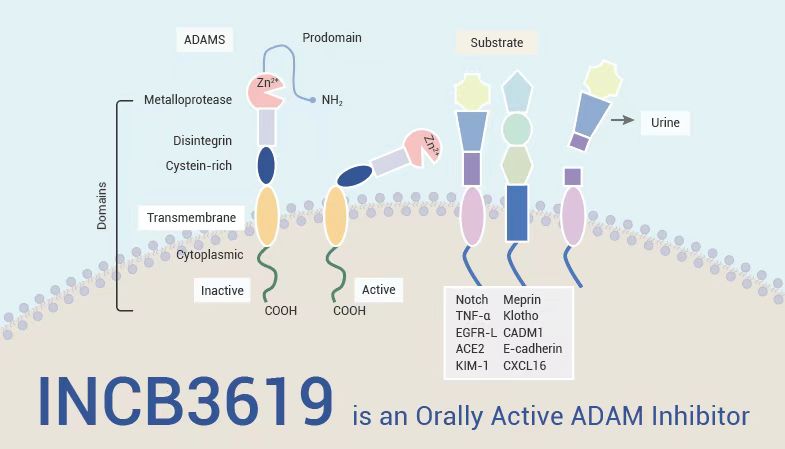ADAM (disintegrin and metalloprotease) family consists of transmembrane proteins with a multidomain extracellular domain, a single transmembrane sequence, and a relatively short cytoplasmic domain. They have diverse biological functions involved in the development, fertility, ectodomain shedding, cell adhesion, inflammation, immunity, neurodegenerative disease, and cancer biology. Along with its structural homolog ADAM17, ADAM10 is one of the best-studied members of the ADAM family. ADAM10 plays an important role in various physiological processes, such as activation of the Notch signaling pathway and inflammatory/immune responses during development. ADAM17 is one of the major shapes involved in a variety of physiological and pathophysiological processes. They include regeneration, differentiation, and cancer progression.
INCB3619 is an orally active ADAM inhibitor with anti-tumor activity.

INCB3619 is a selective and orally active ADAM inhibitor with IC50 of 22 nM and 14 nM for ADAM10 and ADAM17, respectively. In addition, it has anti-tumor activity. In some in vitro experiments, INCB3619 (0-0.25 μM, 96 h) can inhibit the heregulin-dependent HER3-Akt pathway. However, it cannot inhibit ERK activity in A549 cells. It also can induce apoptosis in A549 cells. Besides, INCB3619 (0-10 μM, 72 h) can inhibit EGFR ligand signaling in the EGFR autocrine cell line NCI-H1666. Also, it can be used in combination with other anti-EGFR drugs such as gefitinib. Moreover, it (2 µM) inhibits ERK1/2 expression in NCI-H166 cells and sensitizes them to gefitinib. Also, it can affect the proliferation of NCI-H1666 cells.
In A549 xenografted BALB/c nu/nu mouse model, INCB3619 (subcutaneous injection, 60 mg/kg/d, 14 d) has antitumor activity and sensitizes tumors to gefitinib. Among them, at 60 mg/kg dose, tumor growth inhibition and delay were significant, and at 50 mg/kg dose, the activity was weak.
In short, INCB3619 is a selective and orally active ADAM inhibitor with anti-tumor activity.
Reference:
[1] Bin-Bing S Zhou, et al. Cancer Cell. 2006 Jul;10(1):39-50.
[2] Sebastian Wetze, et al. Biochim Biophys Acta Mol Cell Res. 2017 Nov;1864(11 Pt B):2071-2081.